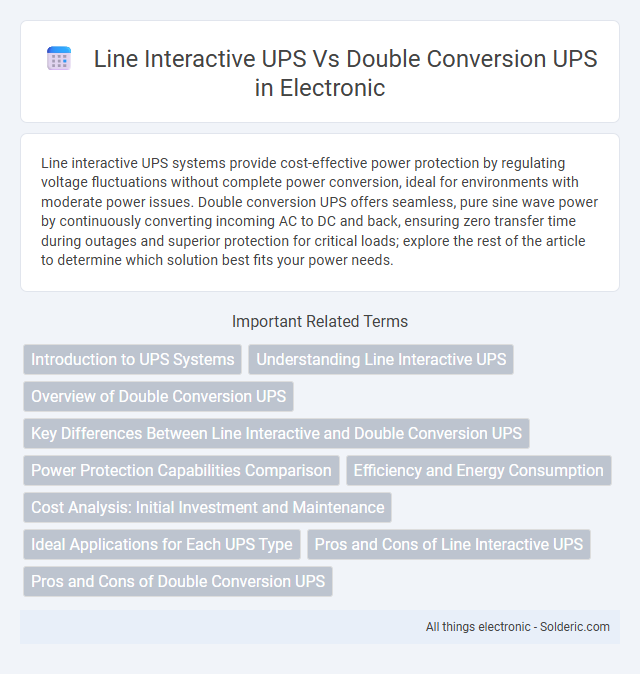Line interactive UPS systems provide cost-effective power protection by regulating voltage fluctuations without complete power conversion, ideal for environments with moderate power issues. Double conversion UPS offers seamless, pure sine wave power by continuously converting incoming AC to DC and back, ensuring zero transfer time during outages and superior protection for critical loads; explore the rest of the article to determine which solution best fits your power needs.
Comparison Table
| Feature | Line Interactive UPS | Double Conversion UPS |
|---|---|---|
| Power Conditioning | Moderate; regulates voltage via autotransformer | High; provides consistent, clean power |
| Output Waveform | Simulated sine wave or stepped approximation | Pure sine wave |
| Transfer Time | Typically 2-8 ms | Zero transfer time (online, no switching) |
| Efficiency | High (up to 95%) | Lower (around 90%) due to continuous conversion |
| Application | Small to medium businesses, home use | Critical data centers, sensitive equipment |
| Cost | Lower initial cost | Higher initial cost |
| Maintenance | Lower complexity, easier maintenance | More complex, requires skilled maintenance |
| Noise Level | Quieter operation | Can be noisier due to constant conversion |
Introduction to UPS Systems
Line interactive UPS systems regulate voltage fluctuations by adjusting transformer taps, providing reliable power backup with moderate sensitivity to power quality issues. Double conversion UPS systems continuously convert incoming AC power to DC and then back to AC, offering superior power conditioning and zero transfer time for critical applications. Both types serve essential roles in uninterruptible power supply, with double conversion favored for highly sensitive or mission-critical equipment.
Understanding Line Interactive UPS
Line Interactive UPS systems provide voltage regulation through automatic voltage regulation (AVR), offering efficient power protection for environments with frequent voltage fluctuations. Unlike Double Conversion UPS, which continuously converts power to ensure zero transfer time and clean output, Line Interactive UPS adjusts the voltage without battery use during minor fluctuations, enhancing battery lifespan and energy efficiency. These systems are ideal for small to medium businesses requiring a balance between cost and reliable power backup.
Overview of Double Conversion UPS
Double conversion UPS, also known as online UPS, provides continuous power by converting incoming AC to DC and then back to clean AC, ensuring zero transfer time during outages and voltage fluctuations. This technology offers superior protection against power disturbances such as surges, sags, and frequency variations, making it ideal for critical applications requiring consistent power quality. You benefit from enhanced reliability and seamless operation in environments demanding the highest level of power integrity.
Key Differences Between Line Interactive and Double Conversion UPS
Line Interactive UPS offers voltage regulation through autotransformers, efficiently managing brownouts and surges without switching to battery, while Double Conversion UPS continuously converts power from AC to DC and back to AC, providing consistent, clean output for sensitive equipment. You benefit from Line Interactive UPS in environments with minor power fluctuations, whereas Double Conversion UPS is ideal for critical applications requiring zero transfer time and complete isolation from power irregularities. Key differences include response speed, power conditioning quality, and cost, with Double Conversion UPS generally offering superior protection at a higher price point.
Power Protection Capabilities Comparison
Line interactive UPS systems provide moderate power protection by regulating voltage fluctuations and offering battery backup during power outages, suitable for environments with frequent but brief outages. Double conversion UPS delivers superior power protection by continuously converting incoming power to DC and then back to AC, ensuring zero transfer time and isolating sensitive equipment from all power disturbances. This makes double conversion UPS ideal for critical applications requiring uninterrupted, clean, and stable power supply.
Efficiency and Energy Consumption
Line interactive UPS systems typically offer higher efficiency and lower energy consumption by regulating voltage without constantly converting power, resulting in around 90-95% efficiency. Double conversion UPS systems maintain a consistent, clean power supply through continuous AC to DC to AC conversion, which, while providing superior power quality, typically results in lower efficiency rates around 85-92% and higher energy usage. For environments prioritizing energy savings, line interactive UPS is more efficient, whereas double conversion UPS is favored for critical applications requiring uninterrupted, high-quality power despite the trade-off in energy consumption.
Cost Analysis: Initial Investment and Maintenance
Line interactive UPS systems offer a lower initial investment and reduced maintenance costs due to simpler design and fewer components compared to double conversion UPS. Double conversion UPS provides superior power conditioning and continuous power supply, but these benefits come with higher upfront expenses and increased maintenance requirements. Your choice between the two should balance budget constraints with the need for power quality and reliability.
Ideal Applications for Each UPS Type
Line interactive UPS systems are ideal for small to medium-sized businesses and home offices where power disturbances are infrequent but voltage fluctuations need correction without constant battery use. Double conversion UPS units suit mission-critical environments like data centers and hospitals where continuous, clean power supply is essential to prevent downtime and hardware damage. Understanding your facility's sensitivity to power interruptions helps determine the best UPS solution for your needs.
Pros and Cons of Line Interactive UPS
Line interactive UPS systems provide efficient voltage regulation and cost-effective power backup, making them ideal for small to medium-sized businesses. Their pros include better energy efficiency and longer battery life compared to double conversion UPS, but they may offer less protection against severe power fluctuations. Your choice depends on the criticality of your equipment and the quality of your power supply environment.
Pros and Cons of Double Conversion UPS
Double conversion UPS provides continuous power conditioning by isolating equipment from power fluctuations, offering superior protection against voltage sags, surges, and harmonic distortions. Its main drawback is higher energy consumption and initial cost compared to line interactive UPS, making it less efficient for small-scale or less critical applications. Your choice should consider the criticality of your load and budget constraints for optimal power protection.
line interactive UPS vs double conversion UPS Infographic

 solderic.com
solderic.com